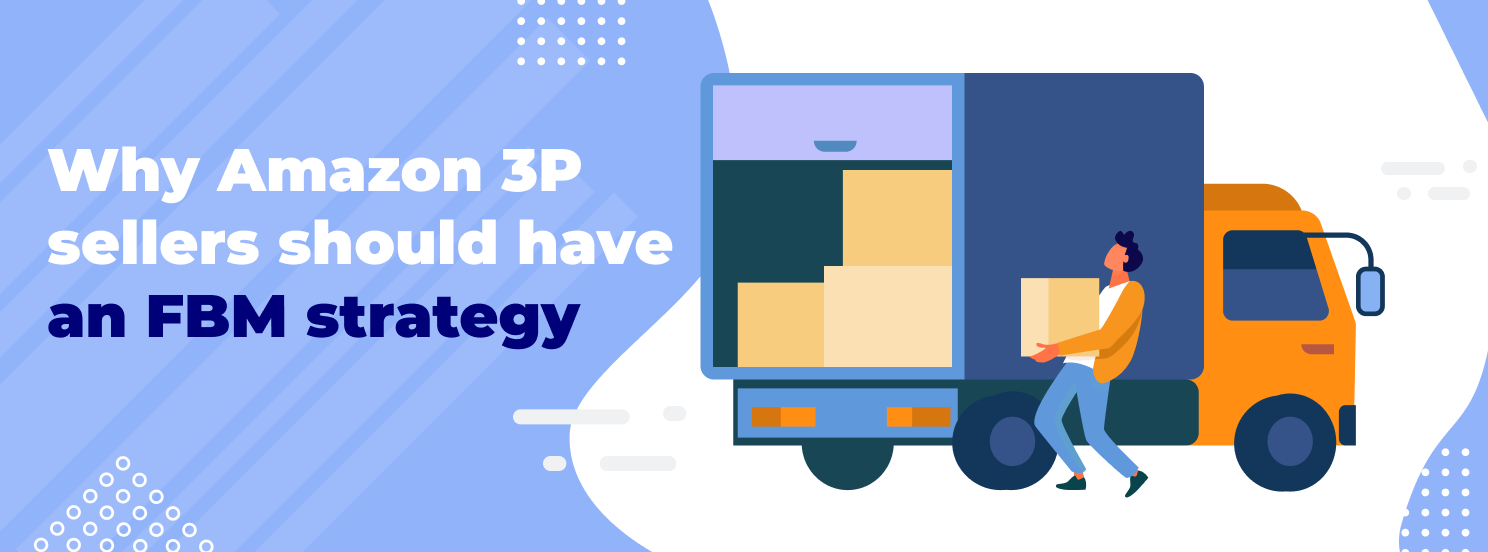
Why Amazon Third-Party Sellers Should Have an FBM Strategy
Selling through Amazon FBA has been a successful strategy for many eCommerce merchants, especially those who started early and established their brand with high sales velocity and good reviews. However, for some 3P sellers, especially newer merchants, FBA may not always be the best fit.
As the USA comes out of lockdowns and is just beginning to pick up again, the end of the pandemic seems to be in sight. Yet with the latest round of storage restrictions in place, FBA sellers might still feel like it’s early 2020, when they were just hit with restrictions on non-essential items and long delivery times.
In order to avoid missing out on sales or going out of stock while scrambling to get inventory into FBA, we’re advising all 3P Amazon sellers to have an underlying FBM strategy that can kick in if something happens to inventory in FBA.
Table of contents
In this article, we’ll cover what FBM is, the benefits of FBM, and different ways to fulfill via FBM.
What is Amazon Fulfilled by Merchant (FBM)?
Before going into Amazon FBM, let’s talk about Fulfillment by Amazon (FBA). FBA is Amazon’s fulfillment arm, where merchants can send items into the Amazon network and have them handle all of their fulfillment.
Amazon FBM is a fulfillment method where the merchant handles all delivery-related aspects. Instead of an order routing to FBA and then Amazon’s internal processes kicking in to fulfill an item, a merchant will be responsible for picking, packing, and shipping their orders to their customers.
There are two methods for starting selling on Amazon with FBM: In-house or outsourced.
1. In-house FBM
In-house FBM means the merchant handles all of the fulfillment processes themselves. They need to rent or own their own warehouse space, track orders and communicate with customers, and work with shipping carriers to ensure their items get delivered on time.
One benefit of this setup is the control you have over every aspect of your fulfillment. You can see your inventory in your own warehouses, and run internal inventory counts.
However, this gets harder to do as you scale. A lack of space and the added managerial requirements of running your own fulfillment can be unsustainable in periods of high growth, making it difficult to stay flexible and adjust to industry changes.
2. Outsourced FBM
Whereas FBA is fulfilled by Amazon, FBM is fulfilled by anyone aside from Amazon. That means you can have external fulfillment companies handle your FBM orders, much like FBA.
For example, you might work with Deliverr to handle all of your FBM orders, and they would still take the fulfillment and logistics off your hands similar to what FBA does.
The key benefits of outsourcing FBM include access to more space, staff, and locations for your inventory. Instead of managing it all yourself, outsourcing frees up that time for you to focus on your core business.
We’ve also seen quite a few Amazon FBA restrictions popping up across our merchants lately. Using FBM is a good way to overcome those restrictions and ensure you don’t go out of stock due to lack of FBA allocation.
Tip: Merchants can use Deliverr for their FBM orders to access transparent pricing, easy onboarding, and fast deliveries.
Benefits of Amazon FBM vs. FBA
1. More Reliability
Selling out on Amazon gives your competitors a chance to capture more of your prospective buyers and surpass you in Amazon search results. This opportunity for them eventually hurts your business as buyers discover and test out your competitors instead of your brand.
Having FBM listings as a backup for your FBA listings will ensure reliability, so that even if your FBA listings sell out, shoppers will still be able to purchase from you.
2. Maintain Control
Using FBA can get complicated and expensive very quickly if things go wrong. For example, if you send items that don’t meet FBA’s strict requirements, you may get charged expensive fees to fix them. Or, they might send them back and penalize your account instead, which will cost both time and money.
Another example of FBA limitations comes from multi-channel selling. Many merchants today are diversifying their businesses by adding more sales channels and streams of revenue. This helps to strengthen their business position and ensure income in case something happens to any of their sales channels.
However, what happens when you sell out on one channel and have to use your FBA-allocated inventory? The process of pulling out inventory from FBA is lengthy and expensive, but might be necessary, especially with recent supply chain issues.
By using FBM, you maintain more control over your inventory. You can avoid hefty fines and prevent a game of “inventory musical chairs” with an Amazon-only fulfillment network.
3. Unify Your Fulfillment
FBA only exists for items sold on Amazon. However, what about your other sales channels?
Selling with FBM means you can use the same fulfillment network across your different marketplaces and for your own D2C orders. This ensures consistency when it comes to your delivery speeds and process.
Unifying your fulfillment also gives you a clear picture of where your items are at all times from a single dashboard and network. This helps reconcile any discrepancies, and make it easier to track reports, invoices, and payments.
What Are Your Next Steps?
After you’ve decided on a fulfillment method for Amazon, be sure to continually optimize your listings. If you’re able to provide fast deliveries with FBM, call it out in your marketing materials.
Here are a few ideas to highlight your fulfillment speeds on Amazon:
Add a shipping promise to your product photos
Highlight your delivery speeds in an FAQs section
Add it as one of your benefits in your product description
Wrapping up - Why Amazon 3P sellers must have an FBM strategy
Selling on Amazon is almost a prerequisite for eCommerce these days, and FBA limits don’t make it any easier. However, having an FBM strategy can diversify and protect your fulfillment.
Outsourcing your FBM deliveries with Deliverr allows you to consolidate your inventory for multiple channels in one network, providing backups for anywhere you sell. Ultimately, it’s important to diversify your fulfillment and add redundancies to keep your revenue streams running strong, and uninterrupted.




